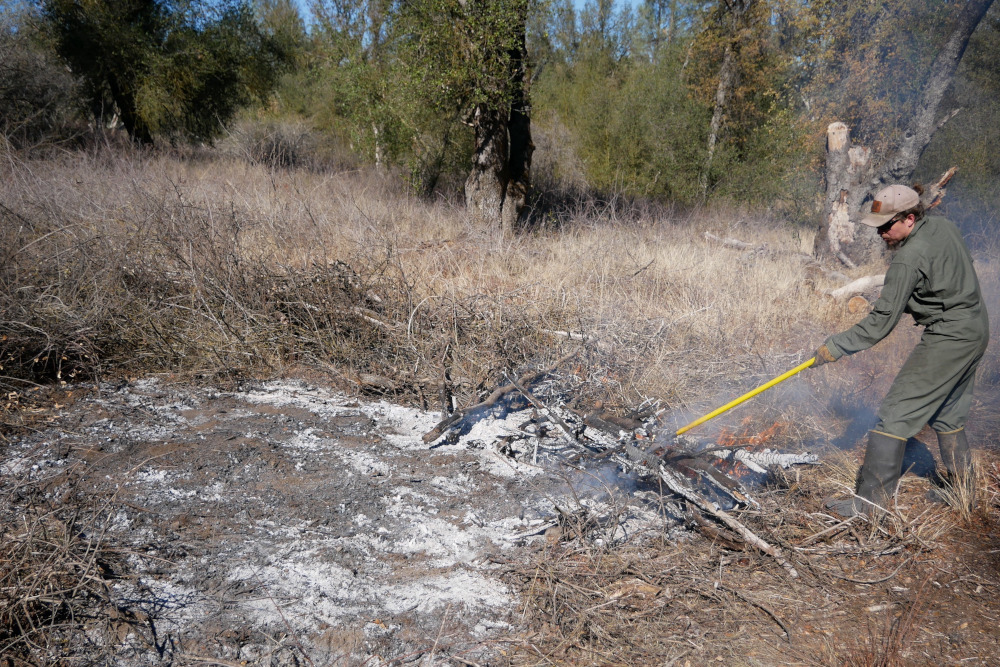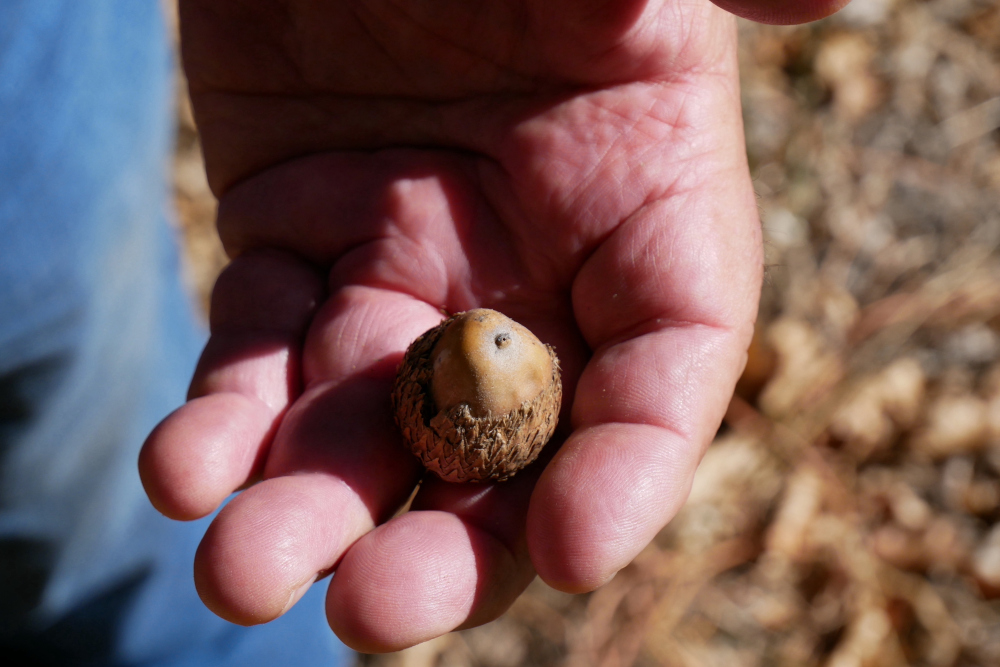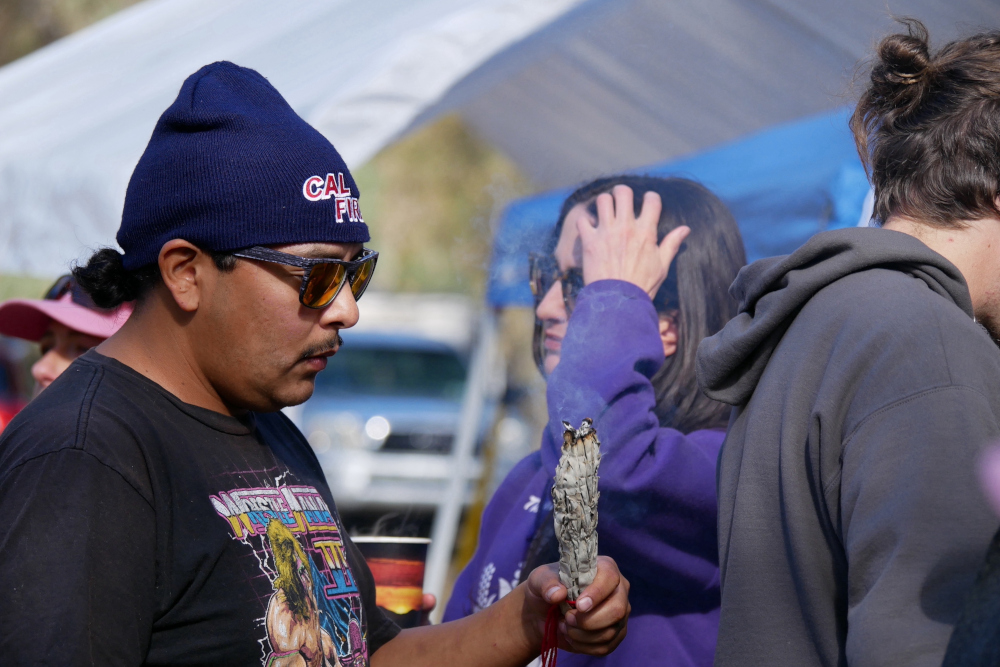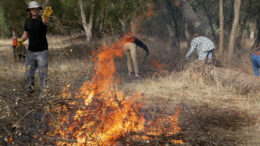Originally published by BioGraphic.
Fire is not coming easily to the pile of dried grass and brush. Four college students fuss with the smoldering heap while Ron Goode, a bear-like man with a graying braid, leans on his cane and inspects their work. Crouch down low, he tells them. Reach farther into the brush with the lighter. Tentative orange flames spring to life and a student in a tie-dyed t-shirt blows gently, imploring them not to die.
It’s a clear November day in the western foothills of California’s Sierra Nevada near the town of Mariposa. The students, visiting from the University of California, Berkeley, are here to help revitalize a patch of live oaks that belongs to Goode’s wife’s family. Goode, the chairman of the North Fork Mono Tribe, is here to teach them how. Now in his early 70s, Goode and his Tribe have worked for decades to restore neglected meadows and woodlands on private property, reservations belonging to other Tribes, and on their own ancestral homelands in the Sierra National Forest. And restoration, in these dry hills, calls for fire.
Dressed in cotton shirts and pants, the students feeding the thread of smoke in the oak grove look more like landscapers than a fire crew. “We’re not firefighters. We’re burners, professional burners,” Goode explains. “And we’re using Native knowledge, traditional ecological knowledge, from centuries ago.” This approach, employed by Native peoples across the world, is known as cultural burning.
Once the fire is rolling, the students use pruning shears to cut more naked stems of Ta-ka-te, or sourberry (Rhus trilobata), down to the ground and toss those onto the now crackling pile. The next morning, after the flames have devoured this fuel, Goode’s grandnephew Jesse Valdez will coach the students on how to mix the cooling ash into the soil with rakes, to fertilize the roots below.

Cultural burning is a kind of gardening. This Indigenous stewardship tradition of clearing, landscaping, and burning mimics natural disturbances, which create a diverse mosaic of habitats and trigger beneficial growth patterns in certain plants. Goode, Valdez, and other practitioners use small, targeted fires to help reshape and rejuvenate landscapes, both for the overall ecological health of the land and for specific cultural purposes, from cultivating traditional foods to sustaining ceremonial practices. Fire, for instance, stimulates Mo-nop’, or deergrass (Muhlenbergia rigens), to explode with flowers. Nium people, as the Mono call themselves, use these flexible flower stalks to weave watertight baskets coiled and patterned like rattlesnakes. And towering Wi-yap’, or black oak (Quercus kelloggii) yield bushels of healthy acorns — once a staple in many Native Californian diets. Low-intensity fires discourage competing conifers, smoke out pests, and clear fuels that threaten to carry flames into the oaks’ more vulnerable crowns. Fire also improves fruit production in berry patches — another key food source for people and animals.

Before foreign colonizers arrived and suppressed the practice, Native Californians often lit low-intensity fires to realize benefits like these. Frequent, low-intensity fire also inoculated the landscape against the kind of destructive megafires that regularly scorch the West Coast today. In fact, fire was so endemic in pre-colonial times that the total area burned in California each year was far greater than that burned by modern megafires. But instead of leaving a blackened moonscape largely devoid of life, the low-intensity fires revitalized the land.
Now, Indigenous peoples across the United States are reclaiming traditional fire stewardship practices, from California and Oregon to Minnesota and Texas. They are reviving their connections to their cultures and homelands, restoring ecosystems, boosting biodiversity, and reducing wildfire risk. In California, they’re even using fire — counterintuitively — to bring water back to the parched land.
“Let’s go way back in time,” Goode says, beginning a Nium story. “Tobahp — Land — married Pia — Water — and they had a mischievous child named Kos. And Kos is Fire. Kos liked to run around out in the forest and leave a trail, and wherever Kos went, his father Pia would follow him and sprinkle water on his trail, and his mother Tobahp would come along and plant flowers and plants.” The ancient allegory describes wildfire in the Sierra, Goode explains: After flames pass over the land, “Water is everywhere, and the first thing that starts popping up are all the cultural plants and the flowers.”
Learning to harness fire and its benefits over millennia allowed Native Californians like the Nium to create and maintain open, park-like landscapes. They wanted clear sightlines to watch for danger and protect their villages and families. And the grassy oak savannas and meadows that they tended with cultural burning were ideal for gathering food, medicines, and other supplies, as well as for travel and hunting.
Meadows are good for more than just people, says Joanna Clines, a Sierra National Forest botanist who has worked with the North Fork Mono on restoration. These wetland ecosystems are often-spring-fed and boast “a huge explosion of diversity,” Clines explains, including dozens of species of sedges, rushes, and grasses, which in turn provide cover and forage for deer, birds, frogs, snakes, and other fauna. Wildflowers like common camas hide delicious bulbs beneath the damp soil and produce blooms that attract native butterflies and bees. Comprising just 2% of the region today — historically they may have covered more than four times that — meadows “are the gems of the Sierra Nevada,” Clines says.
But from the late 18th to the early 20th century, colonists violently removed Indigenous stewards from their meadows, and from the land. Fires were snuffed out or never lit. Indigenous people in the Sierra and beyond were killed in droves, forced to assimilate, and corralled onto reservations. Spanish missionaries were first to ban cultural burning, followed later by the U.S. government. After a devastating complex of wildfires burned 3 million acres in the Northern Rockies in 1911, Congress passed a law establishing a national forest policy of fire prevention and suppression. The Bureau of Indian Affairs later adopted it on reservations.
The land and people are still recovering from their forced separation from fire.
Fifty miles east of Mariposa, Goode surveys a meadow within the North Fork Mono’s homelands, where fragrant native mint and soaproot toast in the autumn sun, alongside a muddy spring. The meadow is part of the 1.3-million-acre Sierra National Forest. For a long time, the Tribe tended deergrass and other resources here, Goode says, but in the early 1980s, many began to feel that the national forest no longer welcomed them in this place. Without the Tribe’s ministrations, ponderosa pines marched in, along with aggressive European invaders like Scotch broom, shading out what had been the largest deergrass bed in their homelands.
In 2003, Dave Martin, a friendly new Forest Service district ranger, invited the North Fork Mono back to this meadow. When the Tribe returned, they found it unrecognizable. But with initial help from an environmental nonprofit and local volunteers, the Tribe chopped brush and selectively logged to mimic what fire would have accomplished had it been allowed. They also performed three cultural burns between 2005 and 2010. Some pines were too large for them to cut or burn, but the utility company PG&E serendipitously felled them later as it cleared space around its powerlines to avoid sparking wildfires.
Freed from thirsty conifers, the meager spring began gushing through the summer. Within a few years, Goode says, these five verdant acres were once again worthy of the label “meadow.” A stately black oak — a favorite tree among many California Tribes — drops acorns at its margin, and Goode points out the sprawling hummocks of returned bunchgrasses, their green glow fading to straw. “These are all the fresh deergrasses,” he says. “They go way up, all the way to the farthest telephone pole now.”
The link between fire and water is well-recognized among fire-dependent Indigenous cultures worldwide, says Frank Kanawha Lake, a Forest Service fire ecologist who collaborates with Goode on research. Historical records suggest that Tribes throughout California, for example, have long known that burning brush makes springs run better and helps save water, according to research by Lake, who has family ties to the Karuk and Yurok. Even in swampy Florida, the Seminole Tribe has a long history of burning in marshes and other damp ecosystems to encourage cultural and medicinal plants that require a higher water table. The Maar-speaking Indigenous peoples of southeastern Australia, meanwhile, tell a story about a vengeful cockatoo who sets a grass fire that prompts a musk duck to shake its wings, filling lakes and swamps with water.
Western science is just starting to catch up with this kind of Indigenous knowledge. Tucked beyond the iconic monolith Half Dome in Yosemite National Park, north of Goode’s restored meadow, Illilouette Creek rushes past streaked granite and patches of charred pines. For almost a hundred years, federal land managers suppressed every blaze in the creek’s fire-adapted basin. Then, in 1968, the National Park Service acknowledged fire’s ecological role with a new policy of “Natural Fire Management.” The policy allowed lightning-caused wildfires to burn in zones where they didn’t threaten human health or infrastructure and where natural fuel breaks contained their reach. By 1972, Yosemite had applied the approach to granite-flanked Illilouette Creek Basin.
In the following four and a half decades, wildfire remade the landscape, though not in the way of the megafires that often grab headlines today. Instead, the blazes were more frequent, smaller, and burned with varying degrees of severity — likely aided at first by the cooler, wetter climate of the 1970s and ’80s. Using aerial photography, ecohydrologist Gabrielle Boisramé and a handful of collaborators discovered that Illilouette Basin’s forest cover shrank by a quarter, more closely approximating historical conditions. New holes appeared in the canopy, filling in with shrublands and meadow-like fields, which have more than tripled in area since 1972. In 2019, Boisramé published a model-based study that suggested these changes have made the basin modestly but notably wetter.
“In the more open areas — which are maintained open by fire — you get deeper snow, and it sticks around longer,” in part because more of it reaches the ground, says Boisramé, who’s now based at the nonprofit Desert Research Institute in Nevada. “That means that water from the snowmelt is getting added to the soil later into the dry season, which is better for vegetation, and can help maintain some of those wet meadows” — as well as boost streamflows and groundwater in a region often grappling with drought. Her previous modeling also shows that fire’s return brings as much as a 30% spike in soil moisture during the summer.
The extra water stored and the smaller number of trees competing for it seem to have helped Illilouette’s trees weather the state’s worst drought in centuries, even as trees in the adjacent Sierra National Forest died in droves, Boisramé says. And the type of fire diversity now found in Illilouette is connected to better long-term carbon storage and greater biodiversity, with documented benefits for bees, understory plants, bats, and birds.
Teasing out fire’s precise and myriad influences on hydrology is challenging, given the many variables involved for any particular place or circumstance. However, Boisramé’s studies are part of a small but growing body of work that suggests frequent fire has long-term hydrologic benefits for ecosystems adapted to such blazes. In the mid-20th century, pioneering fire researcher Harold Biswell found that the prescribed burns he conducted on cattle ranches in the Sierra Nevada foothills helped revive summer-parched springs. That aligns with research in the western U.S. showing that some watersheds — particularly those without substantial groundwater stores to feed waterways — see more water in streams after fire, likely thanks to fewer thirsty plants. Researchers in Australia, meanwhile, recently published a paper suggesting that European colonization of southeast Tasmania created the region’s dry scrublands and devastating megafires by suppressing Indigenous burning that had maintained waterlogged heathlands.
Fire has less direct benefits, too. Inspired by the knowledge of Indigenous burners in the Karuk Tribe, have shown that wildfire smoke can block enough solar radiation to cool rivers and streams by nearly 2.5 degrees Fahrenheit. In some cases, that could offer localized relief to cold-water species like salmon during the changing climate’s hottest summer days.
As more scientists and conservationists recognize the ways Indigenous people shaped ecosystem biodiversity and resilience with fire, there’s an opportunity to return reciprocity to management, says Lake — and to reconnect people and place. “What is our human responsibility, and what are our human services for that ecosystem?” he asks. “How do we prescribe the right amount of fire today, fire as medicine? Traditional knowledge can guide us.”
There is little question that the land needs help. Of the more than 8,200 meadows that the Forest Service has documented in the Sierra Nevada, the agency has listed 95% as unhealthy, or worse, no longer functioning as meadow ecosystems. The North Fork Mono have taken on the task of reviving some of these places in addition to the deergrass meadow that Goode showed me. Working alongside the Forest Service, they’ve begun restoring at least five others in the Sierra National Forest since 2003. In 2018, and again last year, Goode signed five-year agreements with the Forest Service that he hopes will allow the Tribe to restore many more. Those agreements explicitly acknowledge their authority to carry out Indigenous fire management. But their traditional management practices have been challenging to implement.
Goode and his team have so far assessed nine meadows for restoration — and eventually, for cultural burning. They and the Forest Service are working to cut down encroaching conifers and shrubs, clear dead and fallen trees and other vegetation, create piles for burning, remove noxious weeds, clear gullies, and build structures to stabilize eroding soil. All paving the way for vibrant meadows that will hold onto water.
As some elements of those projects move forward, Goode’s team has so far hit a roadblock when it comes to lighting the actual fires. According to Goode, under the agreements, “it’s us putting fire on the ground, and them participating if they wish.” But the Forest Service won’t allow someone to set a fire unless they have a “red card” obtained through rigorous firefighter training.
“The forest is in dire need of restoration, and cultural burning is certainly going to be a key component going forward,” says Dean Gould, Sierra National Forest supervisor. But the agency wants to operate as safely as possible, he adds. Fire practitioners must work in forests laced with buildings and infrastructure, under unprecedented climatic conditions and huge fuel loads. For his part, Gould blames the delay mostly on a lack of capacity. Several recent historic wildfires within the national forest have kept its staff from building a more robust prescribed fire program, which would coordinate cultural burns. The COVID pandemic added other delays, as did a slew of onerous new nation-wide recommendations for prescribed fire that the Forest Service issued in 2022 after losing control of two such burns in New Mexico.
Tribes hoping to implement cultural burning on federal lands commonly face challenges like the ones the Nork Fork Mono has come up against. “[B]oth state and federal agencies lack an adequate understanding of Tribes and cultural fire practitioners, their expertise and authority, land tenure, and the requirements of cultural burns,” write the authors of a report put together for the Karuk Tribe. That, in turn, has led to “confusion, delay, and red-tape,” as well as interference with tribal sovereignty.
“Either we do cultural burning the way it’s supposed to be done, or we’re not going to do it,” says Goode, whose team has more than a hundred small piles of brush prepped and waiting in two Sierra National Forest meadows — ready for them to light and tend the fires before snow falls.

Traditional practitioners often see requirements like red cards as inconsistent with cultural burning, explains Jonathan Long, a Forest Service ecologist who has worked with several Tribes on the issue. Part of the problem is that cultural burning adopts precautions in fundamentally different ways than typical agency burns do. Their intentions and practices, for example, make for safer burns as a general rule. Practitioners tend to ignite only small patches of lower-intensity fire; they welcome both youth and elders to teach and learn; they manicure away risky fuels; and they tend burns closely enough to reduce impacts on cultural resources like deergrass, as well as other plants and wildlife. It’s akin to a city installing bike lanes and traffic-slowing measures so parents can transport kids safely to school by bike, instead of strapping them in car seats inside bulky SUVs. Either way, kids arrive in one piece, but the approaches are vastly different.
There’s also not yet an official playbook for cultural burning within the Forest Service to help guide agency staff, which holds the process back. But Gould says he is part of a regional effort to draft such a policy and that his staff are thinking about how to apply that in the Sierra National Forest.
“I think people are trying to work through, how do we craft the system in ways that will distinguish cultural burning from the wildfire suppression and large prescribed fire events where the risks are different?” says Long.
Still, Long sees more opportunities for traditional fire practices opening up, especially in California, where in recent years the state has rolled out new policies that ease barriers to cultural burning on state and private lands. And at the federal level, in late 2022 the U.S. Forest Service announced 11 major agreements to jointly manage lands with Tribes, including one that allows the Karuk Tribe to conduct cultural burns in partnership with the Six Rivers National Forest in California. The White House followed that announcement with the first-ever national guidance on Indigenous knowledge for federal agencies. The document explicitly recognized the North Fork Mono Tribe for collaborating on research examining cultural burning and climate resilience.
In December, Goode’s grandnephew Valdez trained the Tule River Indian Tribe and Sequoia National Forest staff during a cultural burn at that forest. Sierra National Forest staff also attended, hoping to use the event’s success as a springboard in their own forest, according to Gould. But Goode, now facing serious health issues, is losing patience with the plodding government agency overseeing his Tribe’s homelands, and is even considering legal options for enforcing his Tribe’s right to burn. “You’re not doing it fast enough, not just for the Tribe’s benefit, but for the land,” he says.
As the light retreats after the first day of burning near Mariposa, Goode and Valdez, both of whom also work as tribal archaeologists, gather the students next to a wide meadow. Goode’s wife’s property, where they’ve been working, lies within the ancestral territory of the Miwok people, and a few years ago, Goode, Valdez, and a large volunteer contingent worked with some Miwok to clear and burn this portion of the land. These burns represent an intergenerational transfer of knowledge and culture, a core part of the practice and key to its continuity.
While the sky turns citrus, the group stands atop a massive slab of granite bedrock that emerges from the sea of amber grass like the back of a gray whale. It’s pockmarked with deep, perfectly round holes, some filled with rotting leaves and recent rainwater. Here, the pair explains, the Miwok women who lived in this place at least as far back as 8,000 years ago milled acorns with stone pestles, their daily rhythms grinding permanent impressions into the stone. “They need to be cleaned and cleared out,” Goode says of the mortars. “Right now these are all deteriorating.”
Like the meadow here that needed burning, even features as immutable-seeming as these bedrock mortars need tending. They need the Indigenous stewards whose hands shaped them; and people today to remember how to sustain the land. After the archaeology lesson, everyone piles back into trucks to return for dinner: foil-wrapped potatoes, roasting in the embers of today’s fire.



